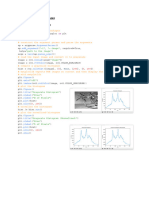Lab01-Image Processing and Analysis
Uploaded by
Dũng HiLab01-Image Processing and Analysis
Uploaded by
Dũng Hi27/9/2019 Lab01-Image Processing and Analysis
Lab01-Image Processing and Analysis
In [6]: import numpy as np
import pandas as pd
import cv2
from matplotlib import pyplot as plt
from pylab import imread
from skimage.color import rgb2gray
file:///C:/Users/Admin/Desktop/Lab01-Image Processing and Analysis.html 1/23
27/9/2019 Lab01-Image Processing and Analysis
In [7]: def imshows(ImageData, LabelData, rows, cols, gridType = False):
# Convert ImageData and LabelData to List
from matplotlib import pyplot as plt
ImageArray = list(ImageData)
LabelArray = list(LabelData)
if(rows == 1 & cols == 1):
fig = plt.figure(figsize=(20,20))
else:
fig = plt.figure(figsize=(cols*8,rows*5))
for i in range(1, cols * rows + 1):
fig.add_subplot(rows, cols, i)
image = ImageArray[i - 1]
# If the channel number is less than 3, we display as grayscale image
# otherwise, we display as color image
if (len(image.shape) < 3):
plt.imshow(image, plt.cm.gray)
plt.grid(gridType)
else:
plt.imshow(image)
plt.grid(gridType)
plt.title(LabelArray[i - 1])
plt.show()
def ShowThreeImages(IM1, IM2, IM3):
imshows([IM1, IM2, IM3], ["Image 1","Image 2", "Image 3"], 1, 3)
def ShowTwoImages(IM1, IM2):
imshows([IM1, IM2], ["Image 1","Image 2"], 1, 2)
def ShowOneImage(IM):
imshows([IM], ["Image"], 1, 1)
def ShowListImages(listImage, row, col):
listCaption = []
for i in range(len(listImage)):
listCaption.append(str(i))
imshows(listImage,listCaption,row,col)
file:///C:/Users/Admin/Desktop/Lab01-Image Processing and Analysis.html 2/23
27/9/2019 Lab01-Image Processing and Analysis
In [8]: # Read Image
image_color = imread("Sample01/motocycle.jpg")
# Convert Image into Gray
image_gray = cv2.cvtColor(image_color, cv2.COLOR_RGB2GRAY)
# Display Image
ShowTwoImages(image_color, image_gray)
file:///C:/Users/Admin/Desktop/Lab01-Image Processing and Analysis.html 3/23
27/9/2019 Lab01-Image Processing and Analysis
In [9]: # Convert Image into HSV color spaces
image_hsv = cv2.cvtColor(image_color, cv2.COLOR_BGR2HSV)
# Show each channel R, G, and B
ShowThreeImages(image_color[:,:,0],image_color[:,:,1],image_color[:,:,2])
# Show each channel H , S and V
ShowThreeImages(image_hsv[:,:,0],image_hsv[:,:,1],image_hsv[:,:,2])
file:///C:/Users/Admin/Desktop/Lab01-Image Processing and Analysis.html 4/23
27/9/2019 Lab01-Image Processing and Analysis
In [10]: hue_img = image_hsv[:,:,0]
hue_threshold = 50
# Show Histogram of Hue Channel
hist = cv2.calcHist([hue_img],[0],None,[256],[0,256])
plt.hist(hue_img.ravel(),256,[0,256])
plt.axvline(x=hue_threshold, color='r', linestyle='dashed', linewidth=2)
plt.title('Histogram for gray scale picture')
plt.show()
# Use threshold to segment object by histogram
hue_binary01 = hue_img > hue_threshold
hue_binary02 = 1 - hue_binary01
ShowTwoImages(hue_binary01, hue_binary02)
file:///C:/Users/Admin/Desktop/Lab01-Image Processing and Analysis.html 5/23
27/9/2019 Lab01-Image Processing and Analysis
file:///C:/Users/Admin/Desktop/Lab01-Image Processing and Analysis.html 6/23
27/9/2019 Lab01-Image Processing and Analysis
In [11]: color = ('r', 'g', 'b')
for channel,col in enumerate(color):
histr = cv2.calcHist([image_color],[channel],None,[256],[0,256])
plt.plot(histr,color = col)
plt.xlim([0,256])
plt.title('Histogram for color scale picture')
plt.show()
file:///C:/Users/Admin/Desktop/Lab01-Image Processing and Analysis.html 7/23
27/9/2019 Lab01-Image Processing and Analysis
In [12]: color = ('r', 'g', 'b')
for channel,col in enumerate(color):
histr = cv2.calcHist([image_hsv],[channel],None,[256],[0,256])
plt.plot(histr,color = col)
plt.xlim([0,256])
plt.title('Histogram for color scale picture')
plt.show()
In [13]: def SegmentColorImageByMask(IM, Mask):
Mask = Mask.astype(np.uint8)
result = cv2.bitwise_and(IM, IM, mask = Mask)
return result
file:///C:/Users/Admin/Desktop/Lab01-Image Processing and Analysis.html 8/23
27/9/2019 Lab01-Image Processing and Analysis
In [14]: hue_binary01_rgb = SegmentColorImageByMask(image_color, hue_binary01)
ShowThreeImages(image_color, hue_binary01, hue_binary01_rgb)
In [15]: # Read Image
image_color = imread("Sample01/cat.jpg")
# Convert Image into Gray
image_gray = cv2.cvtColor(image_color, cv2.COLOR_RGB2GRAY)
# Display Image
ShowTwoImages(image_color, image_gray)
file:///C:/Users/Admin/Desktop/Lab01-Image Processing and Analysis.html 9/23
27/9/2019 Lab01-Image Processing and Analysis
In [18]: # Create Noise Image
noise = np.random.random(image_gray.shape)
image_noise = image_gray.copy()
image_noise[noise > 0.99] = 255
image_noise[noise < 0.01] = 0
ShowThreeImages(image_gray, noise, image_noise)
file:///C:/Users/Admin/Desktop/Lab01-Image Processing and Analysis.html 10/23
27/9/2019 Lab01-Image Processing and Analysis
In [20]: # Create Blurred Image
from skimage.filters.rank import median
from skimage.morphology import disk
image_blurred = median(image_gray, disk(10))
ShowTwoImages(image_gray, image_blurred)
file:///C:/Users/Admin/Desktop/Lab01-Image Processing and Analysis.html 11/23
27/9/2019 Lab01-Image Processing and Analysis
In [45]: from skimage import data, exposure
image_equalization = exposure.equalize_hist(image_gray)
image_equalization = np.float32(image_equalization * 255)
ShowTwoImages(image_gray, image_equalization)
hist = cv2.calcHist([image_gray],[0],None,[256],[0,256])
plt.hist(image_gray.ravel(),256,[0,256])
plt.title('Histogram before equalization')
plt.show()
hist = cv2.calcHist([image_equalization],[0],None,[256],[0,256])
plt.hist(image_equalization.ravel(),256,[0,256])
plt.title('Histogram after equalization')
plt.show()
file:///C:/Users/Admin/Desktop/Lab01-Image Processing and Analysis.html 12/23
27/9/2019 Lab01-Image Processing and Analysis
file:///C:/Users/Admin/Desktop/Lab01-Image Processing and Analysis.html 13/23
27/9/2019 Lab01-Image Processing and Analysis
In [46]: def histogram_equalize(img):
r, g, b = cv2.split(img)
red = cv2.equalizeHist(r)
green = cv2.equalizeHist(g)
blue = cv2.equalizeHist(b)
return cv2.merge((red, green, blue))
file:///C:/Users/Admin/Desktop/Lab01-Image Processing and Analysis.html 14/23
27/9/2019 Lab01-Image Processing and Analysis
In [47]: image_equalization_color = histogram_equalize(image_color)
ShowTwoImages(image_color, image_equalization_color)
file:///C:/Users/Admin/Desktop/Lab01-Image Processing and Analysis.html 15/23
27/9/2019 Lab01-Image Processing and Analysis
In [51]: # Read Image
image_color = imread("Sample01/coffee.jpg")
# Convert Image into Gray
image_gray = cv2.cvtColor(image_color, cv2.COLOR_RGB2GRAY)
# Display Image
ShowTwoImages(image_color, image_gray)
file:///C:/Users/Admin/Desktop/Lab01-Image Processing and Analysis.html 16/23
27/9/2019 Lab01-Image Processing and Analysis
In [60]: # Convert Image into HSV color spaces
image_hsv = cv2.cvtColor(image_color, cv2.COLOR_RGB2HSV)
# Apply histogram equalization
channel = 1
image_hsv[:, :, channel] = cv2.equalizeHist(image_hsv[:, :, channel])
channel = 2
image_hsv[:, :, channel] = cv2.equalizeHist(image_hsv[:, :, channel])
# Convert to RGB
image_enhanced = cv2.cvtColor(image_hsv, cv2.COLOR_HSV2RGB)
ShowTwoImages(image_color, image_enhanced)
file:///C:/Users/Admin/Desktop/Lab01-Image Processing and Analysis.html 17/23
27/9/2019 Lab01-Image Processing and Analysis
In [73]: image_hsv = cv2.cvtColor(image_color, cv2.COLOR_RGB2HSV)
img = image_hsv[:,:,2]
gamma = [0.1, 0.5, 1.2, 2.2, 3.2]
gamma_corrected_01 = np.array(255*(img / 255) ** gamma[0], dtype = 'uint8')
gamma_corrected_02 = np.array(255*(img / 255) ** gamma[1], dtype = 'uint8')
gamma_corrected_03 = np.array(255*(img / 255) ** gamma[2], dtype = 'uint8')
gamma_corrected_04 = np.array(255*(img / 255) ** gamma[3], dtype = 'uint8')
gamma_corrected_05 = np.array(255*(img / 255) ** gamma[4], dtype = 'uint8')
ShowThreeImages(image_gray, gamma_corrected_01, gamma_corrected_02)
ShowThreeImages(gamma_corrected_03, gamma_corrected_04, gamma_corrected_05)
file:///C:/Users/Admin/Desktop/Lab01-Image Processing and Analysis.html 18/23
27/9/2019 Lab01-Image Processing and Analysis
In [74]: channel = 2
image_hsv_01 = image_hsv.copy()
image_hsv_01[:,:,2] = gamma_corrected_01
image_enhanced_01 = cv2.cvtColor(image_hsv_01, cv2.COLOR_HSV2RGB)
image_hsv_02 = image_hsv.copy()
image_hsv_02[:,:,2] = gamma_corrected_02
image_enhanced_02 = cv2.cvtColor(image_hsv_02, cv2.COLOR_HSV2RGB)
image_hsv_03 = image_hsv.copy()
image_hsv_03[:,:,2] = gamma_corrected_03
image_enhanced_03 = cv2.cvtColor(image_hsv_03, cv2.COLOR_HSV2RGB)
image_hsv_04 = image_hsv.copy()
image_hsv_04[:,:,2] = gamma_corrected_04
image_enhanced_04 = cv2.cvtColor(image_hsv_04, cv2.COLOR_HSV2RGB)
image_hsv_05 = image_hsv.copy()
image_hsv_05[:,:,2] = gamma_corrected_05
image_enhanced_05 = cv2.cvtColor(image_hsv_05, cv2.COLOR_HSV2RGB)
ShowThreeImages(image_color, image_enhanced_01, image_enhanced_02)
ShowThreeImages(image_enhanced_03, image_enhanced_04, image_enhanced_05)
file:///C:/Users/Admin/Desktop/Lab01-Image Processing and Analysis.html 19/23
27/9/2019 Lab01-Image Processing and Analysis
In [75]: # With (r1, s1), (r2, s2) as parameters, the function stretches the intensity levels
# by essentially decreasing the intensity of the dark pixels and increasing the intensity
# of the light pixels. If r1 = s1 = 0 and r2 = s2 = L-1, the function becomes a straight
# dotted line in the graph (which gives no effect).
# The function is monotonically increasing so that the order of intensity levels between pixels
# is preserved.
# Function to map each intensity level to output intensity level.
def pixelValTransformation(pix, r1, s1, r2, s2):
if (0 <= pix and pix <= r1):
return (s1 / r1)*pix
elif (r1 < pix and pix <= r2):
return ((s2 - s1)/(r2 - r1)) * (pix - r1) + s1
else:
return ((255 - s2)/(255 - r2)) * (pix - r2) + s2
file:///C:/Users/Admin/Desktop/Lab01-Image Processing and Analysis.html 20/23
27/9/2019 Lab01-Image Processing and Analysis
In [90]: image_hsv = cv2.cvtColor(image_color, cv2.COLOR_RGB2HSV)
image_hsv_value = image_hsv[:,:,2]
hist = cv2.calcHist([image_hsv_value],[0],None,[256],[0,256])
plt.hist(image_hsv_value.ravel(),256,[0,256])
plt.title('Histogram of Image')
plt.show()
# Define parameters.
r1 = 50
s1 = 0
r2 = 200
s2 = 255
# Vectorize the function to apply it to each value in the Numpy array.
pixelVal_vec = np.vectorize(pixelValTransformation)
# Apply contrast stretching.
contrast_stretched = pixelVal_vec(image_hsv_value, r1, s1, r2, s2)
image_hsv[:,:,2] = contrast_stretched
image_enhanced = cv2.cvtColor(image_hsv, cv2.COLOR_HSV2RGB)
ShowTwoImages(image_gray, contrast_stretched)
ShowTwoImages(image_color, image_enhanced)
file:///C:/Users/Admin/Desktop/Lab01-Image Processing and Analysis.html 21/23
27/9/2019 Lab01-Image Processing and Analysis
file:///C:/Users/Admin/Desktop/Lab01-Image Processing and Analysis.html 22/23
27/9/2019 Lab01-Image Processing and Analysis
In [104]: from skimage import feature
# sigma help to remove the noisy image in edge detection
image_edges_01 = feature.canny(image_gray)
image_edges_02 = feature.canny(image_gray, sigma=3)
ShowThreeImages(image_gray, image_edges_01, image_edges_02)
file:///C:/Users/Admin/Desktop/Lab01-Image Processing and Analysis.html 23/23
You might also like
- A Complete Package MCA Entrances by Amit M Agarwal _ PDFNo ratings yetA Complete Package MCA Entrances by Amit M Agarwal _ PDF1,353 pages
- ACFrOgCfX9ATrHm9ZSjs1HLKnJCXmmPcIwFi Y7hVAv6zU1Li3igjIXOOLtGhffODBql8a993YAsc3gM SE8bidlMJr2eFkl9eJB0BU8jcLD6iWrroxwbp1 X9yQtpQks6r8vMLEnR-ORk02lgVJNo ratings yetACFrOgCfX9ATrHm9ZSjs1HLKnJCXmmPcIwFi Y7hVAv6zU1Li3igjIXOOLtGhffODBql8a993YAsc3gM SE8bidlMJr2eFkl9eJB0BU8jcLD6iWrroxwbp1 X9yQtpQks6r8vMLEnR-ORk02lgVJ20 pages
- Gulshan - DIP - Lab - Programs (11 To 20)No ratings yetGulshan - DIP - Lab - Programs (11 To 20)37 pages
- Name-Bhavya Jain College id-19CS19 Batch-C1 Digital Image Processing LabNo ratings yetName-Bhavya Jain College id-19CS19 Batch-C1 Digital Image Processing Lab23 pages
- Image Imread ('Input - JPG') Image - RGB Rgb2gray (Image) F fft2 (Double (Image - RGB) ) Imshow (Abs (Fftshift (F) ), (24 100000) )No ratings yetImage Imread ('Input - JPG') Image - RGB Rgb2gray (Image) F fft2 (Double (Image - RGB) ) Imshow (Abs (Fftshift (F) ), (24 100000) )20 pages
- Programming For Engineers in Python: Recitation 12No ratings yetProgramming For Engineers in Python: Recitation 1239 pages
- TP02 - Image Processing Using Python-OpenCVNo ratings yetTP02 - Image Processing Using Python-OpenCV3 pages
- Course Notes Solutions Answers Image Processing in PythonNo ratings yetCourse Notes Solutions Answers Image Processing in Python99 pages
- 'D:/1234.jpg': cv2 cv2 Numpy Numpy NP NP Matplotlib - Pyplot Matplotlib - Pyplot PLT PLTNo ratings yet'D:/1234.jpg': cv2 cv2 Numpy Numpy NP NP Matplotlib - Pyplot Matplotlib - Pyplot PLT PLT2 pages
- Some Practical Assignments in Computer VisionNo ratings yetSome Practical Assignments in Computer Vision4 pages
- A Review of Image Enhancement Techniques for Underwater ImagesNo ratings yetA Review of Image Enhancement Techniques for Underwater Images5 pages
- Adaptive Forward Differencing For Rendering Curves and SurfacesNo ratings yetAdaptive Forward Differencing For Rendering Curves and Surfaces8 pages
- How To Create A Cyberpunk Photoshop Effect ActionNo ratings yetHow To Create A Cyberpunk Photoshop Effect Action14 pages
- Drucker - Humanities Approaches To Graphical DisplayNo ratings yetDrucker - Humanities Approaches To Graphical Display23 pages
- Digital Compositing for Film and Video Third Edition Steve Wright - Read the ebook now with the complete version and no limits100% (1)Digital Compositing for Film and Video Third Edition Steve Wright - Read the ebook now with the complete version and no limits47 pages
- Timothy Devlin: 703.547.7093 11910 Arden Holly Court Great Falls, VA 22066No ratings yetTimothy Devlin: 703.547.7093 11910 Arden Holly Court Great Falls, VA 2206618 pages
- Full Download Introduction to Computer Graphics with OpenGL ES First Edition Junghyun Han PDF DOCX100% (4)Full Download Introduction to Computer Graphics with OpenGL ES First Edition Junghyun Han PDF DOCX65 pages
- Geometry Best Practices For Unreal EngineNo ratings yetGeometry Best Practices For Unreal Engine27 pages
- Graphics-Multimedia Study Materials PDFNo ratings yetGraphics-Multimedia Study Materials PDF114 pages
- Rickshaw Race Computer Graphics ProjectNo ratings yetRickshaw Race Computer Graphics Project23 pages
- A Complete Package MCA Entrances by Amit M Agarwal _ PDFA Complete Package MCA Entrances by Amit M Agarwal _ PDF
- ACFrOgCfX9ATrHm9ZSjs1HLKnJCXmmPcIwFi Y7hVAv6zU1Li3igjIXOOLtGhffODBql8a993YAsc3gM SE8bidlMJr2eFkl9eJB0BU8jcLD6iWrroxwbp1 X9yQtpQks6r8vMLEnR-ORk02lgVJACFrOgCfX9ATrHm9ZSjs1HLKnJCXmmPcIwFi Y7hVAv6zU1Li3igjIXOOLtGhffODBql8a993YAsc3gM SE8bidlMJr2eFkl9eJB0BU8jcLD6iWrroxwbp1 X9yQtpQks6r8vMLEnR-ORk02lgVJ
- Name-Bhavya Jain College id-19CS19 Batch-C1 Digital Image Processing LabName-Bhavya Jain College id-19CS19 Batch-C1 Digital Image Processing Lab
- Image Imread ('Input - JPG') Image - RGB Rgb2gray (Image) F fft2 (Double (Image - RGB) ) Imshow (Abs (Fftshift (F) ), (24 100000) )Image Imread ('Input - JPG') Image - RGB Rgb2gray (Image) F fft2 (Double (Image - RGB) ) Imshow (Abs (Fftshift (F) ), (24 100000) )
- Programming For Engineers in Python: Recitation 12Programming For Engineers in Python: Recitation 12
- Course Notes Solutions Answers Image Processing in PythonCourse Notes Solutions Answers Image Processing in Python
- 'D:/1234.jpg': cv2 cv2 Numpy Numpy NP NP Matplotlib - Pyplot Matplotlib - Pyplot PLT PLT'D:/1234.jpg': cv2 cv2 Numpy Numpy NP NP Matplotlib - Pyplot Matplotlib - Pyplot PLT PLT
- Digital Image Processing: Fundamentals and ApplicationsFrom EverandDigital Image Processing: Fundamentals and Applications
- A Review of Image Enhancement Techniques for Underwater ImagesA Review of Image Enhancement Techniques for Underwater Images
- Adaptive Forward Differencing For Rendering Curves and SurfacesAdaptive Forward Differencing For Rendering Curves and Surfaces
- Drucker - Humanities Approaches To Graphical DisplayDrucker - Humanities Approaches To Graphical Display
- Digital Compositing for Film and Video Third Edition Steve Wright - Read the ebook now with the complete version and no limitsDigital Compositing for Film and Video Third Edition Steve Wright - Read the ebook now with the complete version and no limits
- Timothy Devlin: 703.547.7093 11910 Arden Holly Court Great Falls, VA 22066Timothy Devlin: 703.547.7093 11910 Arden Holly Court Great Falls, VA 22066
- Full Download Introduction to Computer Graphics with OpenGL ES First Edition Junghyun Han PDF DOCXFull Download Introduction to Computer Graphics with OpenGL ES First Edition Junghyun Han PDF DOCX

























































































